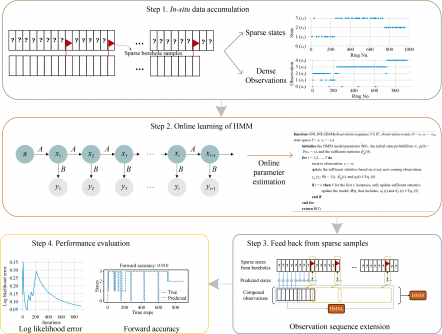Top Stories
Urgent: New Method Improves Tunnel Risk Prediction Accuracy

URGENT UPDATE: A groundbreaking study reveals a new method for predicting geological risks in tunnel excavation, addressing critical safety issues in construction. Researchers from Huazhong University of Science and Technology and Nanyang Technological University have developed an innovative online hidden Markov model (OHMM) that adapts to real-time data, significantly enhancing prediction accuracy.
As tunnel construction projects often face hazards like collapses and water inrush, accurate geological risk assessment is vital. Traditional techniques, including invasive borehole logging and non-invasive seismic methods, struggle with data limitations and accuracy issues. The new OHMM tackles these challenges by dynamically updating its parameters with each new observation, offering timely insights that can prevent costly delays and safety incidents.
This research, published in the journal Geological Risk Prediction Under Uncertainty in Tunnel Excavation Using Online Learning and Hidden Markov Model, emphasizes the importance of adapting to the incremental data generated during tunnel excavation. The study’s authors, including Limao ZHANG and Ying WANG, conducted a comprehensive case study on a tunnel project in Singapore, which involved 915 rings of data.
The OHMM demonstrated exceptional performance, achieving a forward prediction accuracy of 0.968 with just 300 observed rings. Even with 600 rings, it maintained an impressive accuracy of 0.902, outperforming traditional methods like LSTM networks and support vector machines (SVM). This capability allows for the accurate forecasting of geological risks in unexcavated areas, a breakthrough in construction safety.
Notably, the model can provide stable predictions for up to 100 rings ahead, with a recommended foresight distance of 30 rings for practical guidance. This advancement is crucial for mitigating risks in tunnel excavation, ensuring safer work environments for construction crews.
Officials highlight the significance of this research in the broader context of civil engineering, as it paves the way for more efficient and safe tunneling practices. The study’s findings are available in full at https://doi.org/10.1007/s42524-024-0082-1.
As tunnel projects continue to evolve, the implementation of the OHMM could revolutionize how geological risks are assessed, potentially saving lives and resources. Stay tuned for further updates on this developing story.
-

 Business4 days ago
Business4 days agoUK to Finalize Stablecoin Regulations by 2026, Boosting Crypto Sector
-

 Business5 days ago
Business5 days agoU.S. and U.K. Target Cybercriminal Networks, Seize $15 Billion
-

 Lifestyle5 days ago
Lifestyle5 days agoKISS OF LIFE’s Natty Dazzles in Micro-Shorts at Seoul Event
-

 World4 days ago
World4 days agoMilitary Artillery Plan Sparks Safety Concerns Along California Highway
-

 World5 days ago
World5 days agoTrump Signals Reluctance to Sell Tomahawk Missiles to Ukraine
-

 Business5 days ago
Business5 days agoCalifornia to Eliminate All Plastic Bags from Stores by 2026
-

 Entertainment5 days ago
Entertainment5 days agoLouisiana Senate Raises Concerns Over Medicaid Cuts Amid New Bill
-

 Entertainment5 days ago
Entertainment5 days agoUtah Communities Rally as Government Shutdown Strains Resources
-

 Sports5 days ago
Sports5 days agoDomenico Doran’s Stellar Performance Leads Bishop Amat to Victory
-

 Sports5 days ago
Sports5 days agoTrade Low, Trade High: Key NHL Players to Consider Now
-

 Science2 days ago
Science2 days agoAncient Dinosaur Discovery in Argentina Reveals Evolutionary Insights
-

 Health2 days ago
Health2 days agoUncovering the Hidden Link Between Knee Pain and Hip Issues









